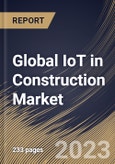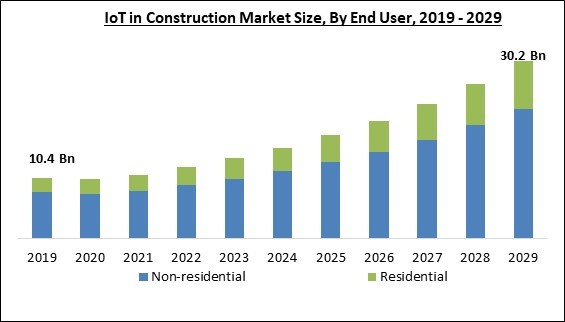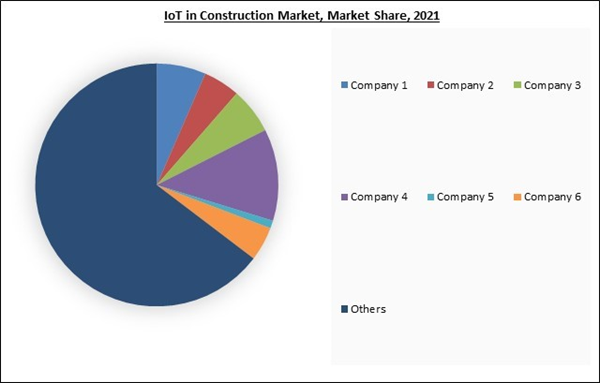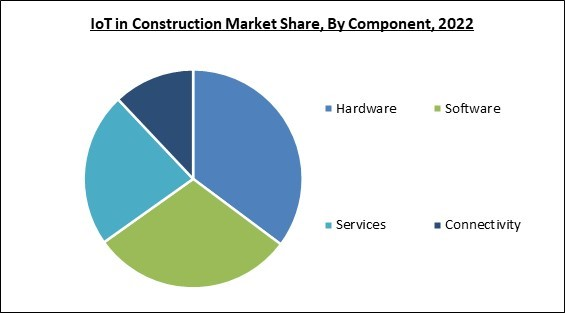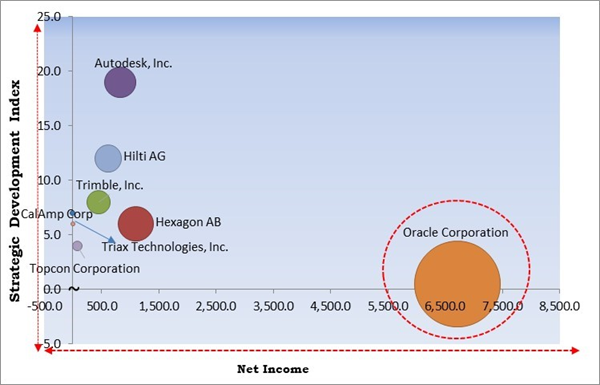The Global IoT in Construction Market size is expected to reach $30.2 billion by 2029, rising at a market growth of 14.1% CAGR during the forecast period.
IoT in construction market primarily aims to use electronically connected equipment and software to provide efficient resource usage, a well-thought-out technological approach, and controlled construction costs. In addition, IoT provides a framework for connecting employees, inventories, and equipment to a centralized server that manages and monitors their operations in real-time. Nowadays, various technology is used in the construction industry for various purposes.
Risks at construction sites include scaffold collapse, trench collapse, falls, repetitive motion injuries, a lack of adequate safety gear, and others. Construction IoT integration and smart wearables provide real-time site safety management, such as smart helmets, smart glasses, safety vests, wearable sensors, wearable hex-skeletons, and others. Additionally, active data monitoring using such wearable technology enables the measurement of heart rate and breathing rate and the active observation of a worker's body's reaction to a particular work environment.
Construction sites are connected via IoT-based solutions that use sensors, CCTV cameras, drones, and RFID tags. As a result, real-time statistics regarding inventories, workforce, and ongoing activities are now available. Among other advantages, sensors and RFID tags on materials enable efficient workflows, equipment servicing, prompt material ordering, monitoring of equipment usage, and preventative maintenance. Furthermore, to avoid delays & save time and money, efficient time management minimizes employee and equipment downtime on construction sites.
The leading players in the market are competing with diverse innovative offerings to remain competitive in the market. The illustration shows the percentage of revenue shared by some of the leading companies in the market. The leading players of the market are adopting various strategies in order to cater demand coming from the different industries. The key developmental strategies in the market are Acquisitions, and Partnerships & Collaborations.
The major strategies followed by the market participants are Product Launches. Based on the Analysis presented in the Cardinal matrix; Oracle Corporation is the major forerunner in the IoT in Construction Market. Companies such as Topcon Corporation, Autodesk, Inc., and Trimble, Inc. are some of the key innovators in IoT in Construction Market.
The market research report covers the analysis of key stake holders of the market. Key companies profiled in the report include Autodesk, Inc., Advanced Opto-Mechanical Systems and Technologies Inc., CalAmp Corp, Hexagon AB, Hilti AG, Oracle Corporation, Topcon Corporation, Triax Technologies, Inc., Trimble, Inc., and Giatec Scientific Inc.
IoT in construction market primarily aims to use electronically connected equipment and software to provide efficient resource usage, a well-thought-out technological approach, and controlled construction costs. In addition, IoT provides a framework for connecting employees, inventories, and equipment to a centralized server that manages and monitors their operations in real-time. Nowadays, various technology is used in the construction industry for various purposes.
Risks at construction sites include scaffold collapse, trench collapse, falls, repetitive motion injuries, a lack of adequate safety gear, and others. Construction IoT integration and smart wearables provide real-time site safety management, such as smart helmets, smart glasses, safety vests, wearable sensors, wearable hex-skeletons, and others. Additionally, active data monitoring using such wearable technology enables the measurement of heart rate and breathing rate and the active observation of a worker's body's reaction to a particular work environment.
Construction sites are connected via IoT-based solutions that use sensors, CCTV cameras, drones, and RFID tags. As a result, real-time statistics regarding inventories, workforce, and ongoing activities are now available. Among other advantages, sensors and RFID tags on materials enable efficient workflows, equipment servicing, prompt material ordering, monitoring of equipment usage, and preventative maintenance. Furthermore, to avoid delays & save time and money, efficient time management minimizes employee and equipment downtime on construction sites.
COVID-19 Impact Analysis
The majority of industry verticals and the world economy were significantly impacted by the COVID-19 pandemic. During the lockdown phase of the COVID-19 pandemic, the market for IoT in construction has been significantly impacted. Decreased sales of new construction robots, corresponding aftermarket services, and restrictions on building operations led to the decline. The COVID-19 pandemic profoundly affected the construction, industrial, hotel, and tourism industries. This led to a decline in the output of construction equipment, which impacted the market for IoT in construction.Market Growth Factors
Rising productivity and safety provided by IoT on construction sites
The construction sector can benefit greatly from IoT. The advantages of the technology have already been established in the manufacturing, healthcare, automotive, and other sectors where systems management and automation are essential. With its multiple uses, loT has the ability to enhance security and boost output on building sites. Systems & devices that are connected to one another can be synced to a central server for easier monitoring. As a result, supervisors may accomplish their duties quickly and are notified of all the elements of a project. These benefits offered by IoT adoption in construction sector are supporting market growth.Rising adoption of construction robotics offering growth prospects
Construction robotics is the practice of carrying out construction tasks automatically with the aid of construction robots or automated construction machinery. It is employed in tasks including constructing and destroying infrastructures for homes, businesses, and industries. Construction tasks now involve less or no human interaction due to construction robotics. Although robotics has been employed in the construction industry for some time, very few commercial robots are still being deployed there. As a result, the market share for IoT in construction is expected to increase as demand for robotics in construction rises.Market Restraining Factors
More dependence on conventional methods
In the construction industry, digitization is lesser than in other industries. The construction industry experiences low productivity due to a lack of digitization. Large-scale building projects frequently conclude later than originally planned and incur additional costs, reducing contractors' financial returns. Since most of the work is done on paper, there's not much coordination between the office and the field regarding project planning. This, in turn, leads to inefficient management of the supply chain. This disparity may present a problem for companies with a foothold in the market.The leading players in the market are competing with diverse innovative offerings to remain competitive in the market. The illustration shows the percentage of revenue shared by some of the leading companies in the market. The leading players of the market are adopting various strategies in order to cater demand coming from the different industries. The key developmental strategies in the market are Acquisitions, and Partnerships & Collaborations.
Application Outlook
Based on application, the IoT in construction market is segmented into asset monitoring, predictive maintenance, fleet management, wearables and others. The fleet management segment procured a promising growth rate in the IoT in construction market in 2022. Telematics, also referred to as fleet management, provides a range of solutions, such as driver behavior, vehicle tracking, fleet safety, fleet management, and economical driving. In addition, fleet management provides daily information about fleet operations, weak points, equipment downtimes, and upcoming tasks to minimize fuel consumption and maximize vehicle productivity.End user Outlook
On the basis of end-user, the IoT in construction market is classified into residential, and non-residential. In 2022, the non-residential segment witnessed the largest revenue share in the IoT in construction market. Hospitals, resorts, office complexes, and infrastructure projects are all included in non-residential construction. Large-scale commercial construction projects demand highly skilled planning, designing, and management of resources, personnel, staff, and equipment. IoT technology improves project productivity and decreases operational delays across various construction tasks.Component Outlook
By component, the IoT in construction market is bifurcated into hardware, software, services and connectivity. The services segment acquired a substantial revenue share in the IoT in construction market in 2022. Implementing services such as retrofitting, routine maintenance, and personnel training preserves the equipment's efficiency and production, hence lowering unnecessary or unintended expenses. Recognizing these benefits may contribute to the expansion of services segment in the IoT in construction market.Regional Outlook
Region wise, the IoT in construction market is analyzed across North America, Europe, Asia Pacific and LAMEA. In 2022, the North America region led the IoT in construction market by generating the largest revenue share. It results from new technology's quick adoption on construction sites across Canada and the U.S. The high consumer spending on advanced technologies drives people to use IoT-connected devices. Although many companies have corporate headquarters in the United States, the cost of cutting-edge new technology is relatively affordable in this region. These factors support the regional IoT in construction market.The Cardinal Matrix - IoT in Construction Market Competition Analysis
The major strategies followed by the market participants are Product Launches. Based on the Analysis presented in the Cardinal matrix; Oracle Corporation is the major forerunner in the IoT in Construction Market. Companies such as Topcon Corporation, Autodesk, Inc., and Trimble, Inc. are some of the key innovators in IoT in Construction Market.
The market research report covers the analysis of key stake holders of the market. Key companies profiled in the report include Autodesk, Inc., Advanced Opto-Mechanical Systems and Technologies Inc., CalAmp Corp, Hexagon AB, Hilti AG, Oracle Corporation, Topcon Corporation, Triax Technologies, Inc., Trimble, Inc., and Giatec Scientific Inc.
Strategies Deployed in IoT in Construction Market
Partnerships, Collaborations and Agreements:
- Nov-2022: Trimble teamed up with Exyn Technologies, a hardware provider and robotics company. Following this collaboration, Trimble would improve safety, productivity, and quality of work on construction sites.
- Oct-2022: Hexagon collaborated with AVVIR following which it integrated AVVIR’s AI-powered technology stack into its suite of solutions that addresses the challenges of the construction lifecycle. Hexagon's ability to deliver intelligent digital realities that enable an autonomous workflow approach to construction is strengthened by the integration of AVVIR's proven design-vs-reality analysis platform with their full suite of reality capture solutions and services as well as their BIM and virtual design and construction (VDC) solutions.
- Feb-2022: Hilti partnered with Trackunit, a provider of SaaS-based IoT solutions, for the advancement of digital transformation in the construction sector. The partnership also enabled Hilti to broaden the scope of its ON!Track solutions to include heavy machinery in addition to light equipment, while developing a cutting-edge van inventory management solution for all client categories in the construction sector.
- Sep-2021: CalAmp announced its partnership with Hyundai Translead, a manufacturer of dry and refrigerated van trailers, flatbeds, chassis, and dollies in North America, for launching a new open platform smart trailer solution. The new platform smart trailer solution would give transportation businesses detailed visibility into the condition and use of their trailers. The new platform enables fleet owners to visualize trailer position, health, and consumption through the CalAmp iOn web application by integrating an ecosystem of top industry sensors with CalAmp's smart trailer solar gateway and CalAmp Telematics Cloud (CTC). To further streamline their processes, they may integrate these data insights into their current corporate management systems by utilizing industry-standard Application Programming Interfaces (APIs).
- Jun-2021: Trimble came into collaboration with Worldsensing, a provider of wireless connectivity technology and manufacturer of geotechnical IoT monitoring systems, for the addition of a geotechnical portfolio to its geospatial automated monitoring suite. The collaboration allowed geotechnical, survey, and structural engineers to seamlessly expand their monitoring business opportunities with a comprehensive solution that includes geospatial and geotechnical data.
Product Launches and Product Expansions:
- Mar-2023: Autodesk introduced facility monitoring Beta for Tandem, a digital twin application of Autodesk for AEC. Tandem can go deep into the data lake and get useful information, identify usage patterns and trends, and zero in on problems. The workers can analyze the performance of offices remotely and observe how everything is developed, installed, and connected because of a digital twin with facilities monitoring capabilities.
- Sep-2021: CalAmp's subsidiary, LoJack Italia, introduced CalAmp iOn in Italy, the completely integrated asset and fleet management solution that helps government, transportation, commercial, industrial, and service fleet operators in minimizing costs, increasing operational efficiency, and improving fleet safety. With the help of the CalAmp iOn suite of online and mobile SaaS telemetry services, Utility managers for fleets can quickly distribute these resources in the field by knowing exactly where their essential assets are. Fleet operators will have access to precise and crucial data with the CalAmp iOn platform's integration of fleet tracking with Esri® ArcGIS® insight, which may substantially enhance their operations, and profitability, and even save lives.
- May-2021: Triax Technologies introduced a streamlined IoT solution, Spot-r Radius, for broadening its Spot-r portfolio of solutions. A self-deployable and portable wearable system called Spot-r Radius offers crucial worker-to-worker, worker-to-location, and worker-to-equipment-based intelligence to convey insightful information about everyday operations. Spot-r Radius automates headcount and hours for daily reporting and labor billing verification tracks equipment utilization, finds bottlenecks causing inefficiencies on site, and supports social distancing and digital contact tracing as necessary. These features are in addition to real-time safety alerts that proactively warn workers before entering hazardous areas or no-go zones. Its analytics reports, which are routinely uploaded to the cloud after each day, assist organizations in increasing overall site efficiency and monitoring risk and worker behavior KPIs.
- Mar-2021: Hilti released ON!Track 3.0, an Internet of Things (IoT) platform. It is a software solution that delivers clarity and efficiency to businesses, instantly, while reducing overhead and operational costs. Customers can use a cloud-based integrated solution that offers a higher level of control and information access. To help them make smarter, safer decisions, the company is giving them access to more data-driven insights.
Mergers and Acquisitions:
- Mar-2023: Topcon Positioning Systems took over Digital Construction Works, a construction software and data integration and services company. Being a part of Topcon, the DCW integrations platform improves the value of Topcon's compatibility with outside software that is frequently used to carry out machine-guided tasks. Automating report production and removing human data entry across a multi-vendor and multi-stakeholder project context, saves users time and money.
- Jan-2023: Trimble completed the acquisition of Ryvit, a marketplace of construction technology. The acquisition accelerated and expanded the connected construction workflows of Trimble.
- Sep-2022: Hexagon completed the acquisition of iConstruct Pty Ltd, a developer of BIM software utilized in infrastructure, commercial, and industrial construction. The acquisition added iConstruction's offerings that provide opportunities to Hexagon's Asset Lifecycle Intelligence and Geosystems divisions. With iConstruct, both parties participating in the building process may provide project planning, higher data management, and communication efficiency to additional clients, segments, and disciplines.
- Mar-2022: Autodesk took over The Wild, the extended reality software startup. This acquisition served as the foundation of Autodesk’s XR journey and would be an addition to the company’s construction software portfolio with more products.
Scope of the Study
By End-user
- Non-residential
- Residential
By Component
- Hardware
- Software
- Services
- Connectivity
By Application
- Predictive Maintenance
- Asset Monitoring
- Wearables
- Fleet Management
- Others
By Geography
- North America
- US
- Canada
- Mexico
- Rest of North America
- Europe
- Germany
- UK
- France
- Russia
- Spain
- Italy
- Rest of Europe
- Asia Pacific
- China
- Japan
- India
- South Korea
- Singapore
- Malaysia
- Rest of Asia Pacific
- LAMEA
- Brazil
- Argentina
- UAE
- Saudi Arabia
- South Africa
- Nigeria
- Rest of LAMEA
Key Market Players
List of Companies Profiled in the Report:
- Autodesk, Inc.
- Advanced Opto-Mechanical Systems and Technologies Inc.
- CalAmp Corp
- Hexagon AB
- Hilti AG
- Oracle Corporation
- Topcon Corporation
- Triax Technologies, Inc.
- Trimble, Inc.
- Giatec Scientific Inc.
Unique Offerings
- Exhaustive coverage
- The highest number of Market tables and figures
- Subscription-based model available
- Guaranteed best price
- Assured post sales research support with 10% customization free
Table of Contents
Chapter 1. Market Scope & Methodology
Chapter 2. Market Overview
Chapter 3. Competition Analysis - Global
Chapter 4. Global IoT in Construction Market by End User
Chapter 5. Global IoT in Construction Market by Component
Chapter 6. Global IoT in Construction Market by Application
Chapter 7. Global IoT in Construction Market by Region
Chapter 8. Company Profiles
Companies Mentioned
- Autodesk, Inc.
- Advanced Opto-Mechanical Systems and Technologies Inc.
- CalAmp Corp
- Hexagon AB
- Hilti AG
- Oracle Corporation
- Topcon Corporation
- Triax Technologies, Inc.
- Trimble, Inc.
- Giatec Scientific Inc.
Methodology

LOADING...


